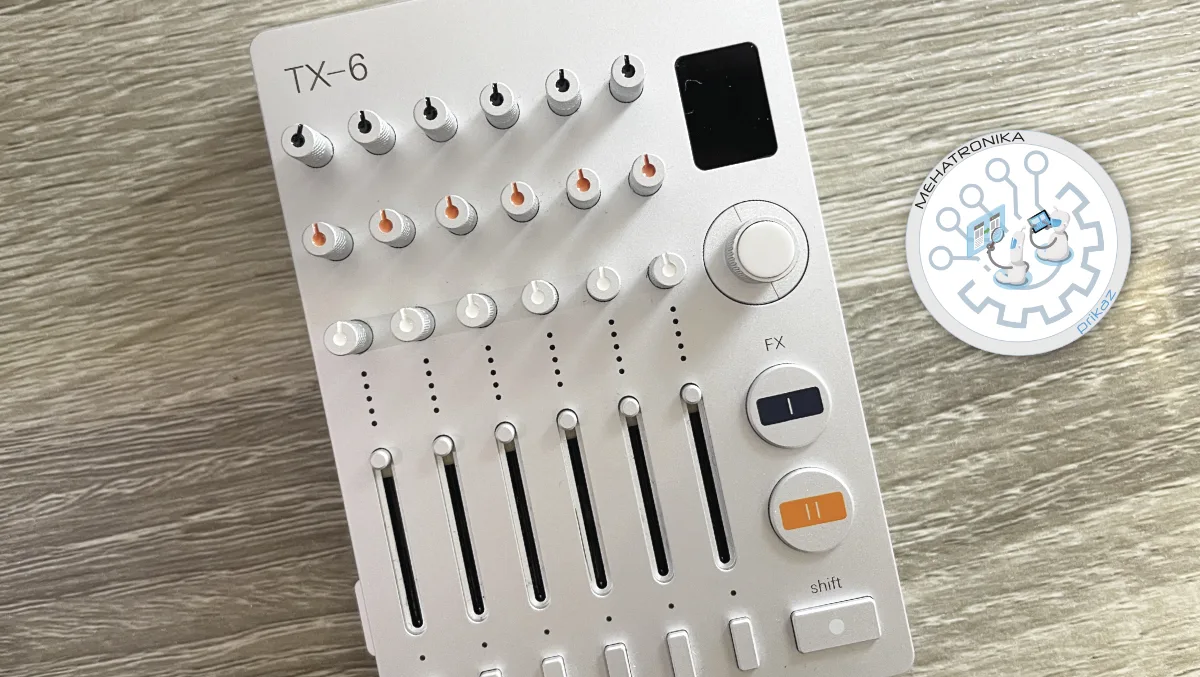teenage engineering TX-6
The TX-6 is a wonderfully tiny and charming mixer and audio interface from teenage engineering. It is characteristically playful and quirky, as all devices from the brand are. Packing in a mix of industry standard and completely unique features, it fully justifies its high price tag and deserves a spot in your traveling (or studio) recording setup.
Pros
- High quality build and construction
- Perfect audio quality
- Extremely versatile and powerful
- Tiny!
Cons
- Might be a little bit uncomfortable to use for those with large hands
Each time we get a bit of teenage engineering kit, it takes us on a journey during our review. The Swedish company seems to make just about anything they feel like making – which includes everything from serious, albeit quirky music devices – to adorable record cutters and singing dolls. This playful variety is what defines the brand – and what makes the brand. Reviewing their more “serious” products in the past – we’ve still stumbled upon heaps and heaps of personality. It’s certainly interesting and charming to see a brand push out products they truly want to.
This philosophy definitely gave rise to the TX-6 – a tiny battery-powered portable mixer with a bunch more features packed right in. It’s just… a peculiar device which has so much going on under the hood that calling it a “mixer” feels almost wrong – for it is so much more than that.
But a mixer at heart it is! The six stereo channels (which can be also used as up to 12 unbalanced mono channels or 6 balanced mono channels), six channel control strips and a two-slot effect processor define the main workflow of the TX-6. The inputs for these are found along the top edge – spaced incredibly tightly alongside the USB-C port used for charging and digital audio. On the bottom side there are two buttons (which we’ll explore shortly) and three outputs – a main audio out, an auxiliary out for effect loops and a cue out for monitoring. The sides are mostly empty – save for a single white flip-switch and a status LED right next to it. The whole chassis is built out of a solid block of aluminium. It might seem like a vanity-driven choice – but given its size a relatively heavyweight material needed to be used to stop it from flying off the table upon the slightest tug at any of the cables connected to it (faux leather was also put on the back to provide some grip – while it looks visually stunning, rubber feet might have worked a bit better for this). An adorably tiny OLED display wraps the design up – and displays useful data by utilising a clever UI.
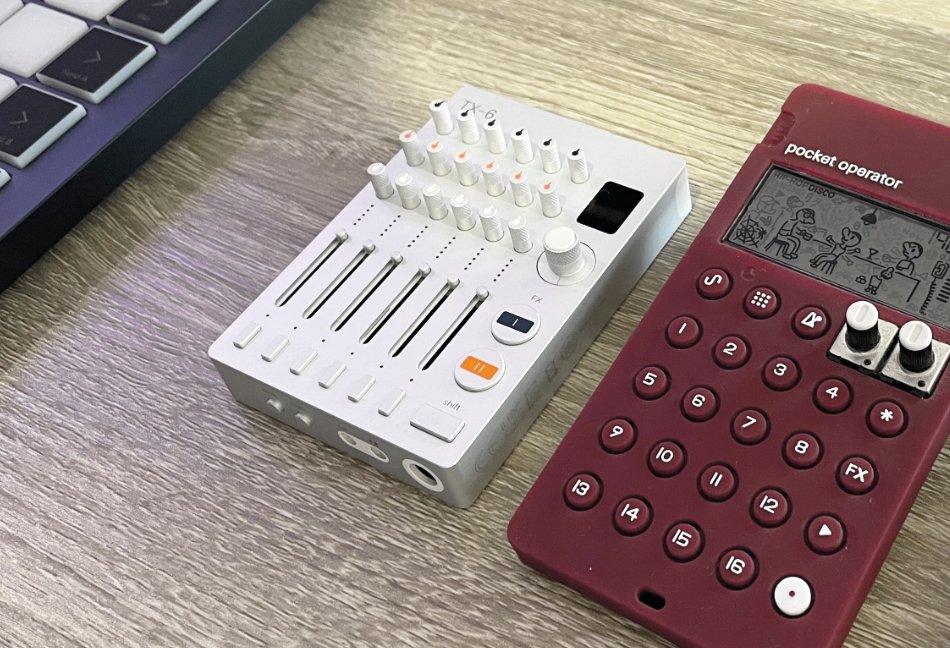
Before digging deep into the TX-6 – it’s worth noting once again how tiny this device is – its 9cm by 6.2cm footprint is minuscule. It’s so small and compact that the headphone adapter almost looks like it should be a volume knob (and that’s what we thought it was upon originally seeing the design – not to mention that it’s larger than the actual master volume encoder).
Teenage engineering has generously sent us the TX-6, alongside a set of slimline cables and a matching bag for the mixer. However, all opinions stated here are our own and were not directly influenced by the company. So – without further ado – let’s dig into each major set of features the TX-6 has and see how it performs.
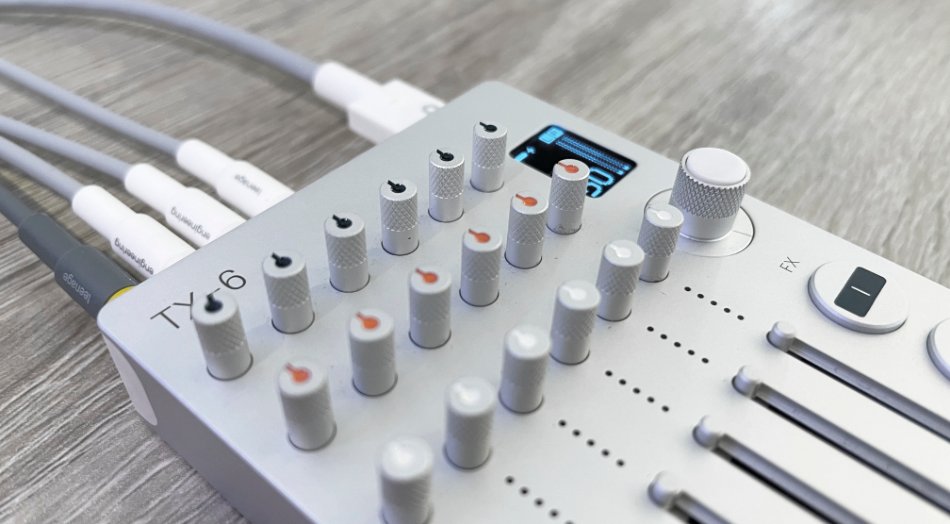
Starting with its use as a mixer – the TX-6 performs great. Each of the channels has a dedicated channel strip – with a tiny fader, five level LEDs and three assignable knobs. These knobs are initially assigned to a three-band equaliser, but can also be reassigned to a track’s compressor, gain, panning and an HP/LP filter. These are all standard mixer features which would usually have dedicated controls. Due to the space limitations, they were grouped together under a “track menu” of sorts – and a simple key combo cycles through these. It’s not the most wieldy solution – but it works and it enables quick changes.
The equaliser is a classic three-band one – capable of tweaks of up to 18dB. There’s no option to choose the exact frequencies it targets – but that’s the case with many mixers. Overall – it serves the purpose of quickly adjusting sounds which are too bright or muddy in a mix.
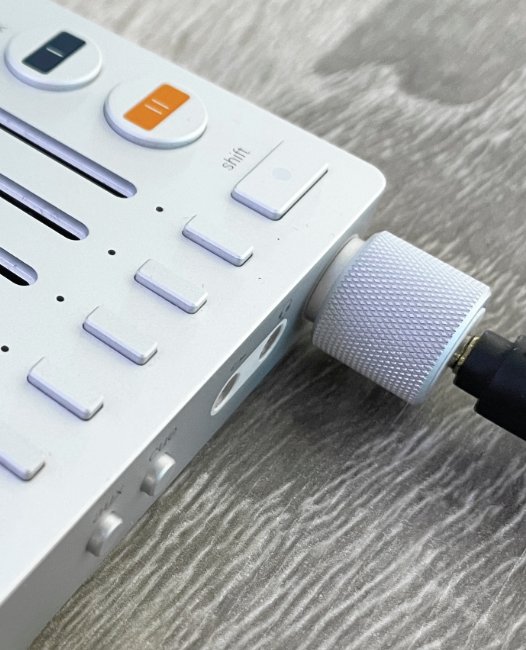
The compressor is a bit hard-hitting. It’s undoubtedly useful for squeezing softer patches and instruments through – and can be used to great effect for adding a percussive element to the timbre. The limited controls provided (no ratio and no direct threshold control, for example) do limit its usability. However, it’s still rather powerful as a tool – and its quality can be heard in the first audio example.
The gain is pretty impressive – especially given that it’s analog. Proper analog gain in a palm-sized device is almost unheard of – and the very respectable 42dB gain range is nothing to scoff at. Of course – at these high settings the noise floor gets amplified quite a lot – but such capable analog preamps are marvellous for a device this size.
The per-channel filter is also high-quality. It’s a high-pass or low-pass filter with no resonance. It sounds great and is capable of effectively shaping timbral quality in tandem with the equaliser. Each track has its own separate filter – of course – and it makes for a powerful feature.
The headroom each channel provides is great. Inputs can take line level signal – but sadly not modular level. Still, this higher sensitivity (and good gain amps) mitigate the need for external preamps for some weaker signal sources – like headphone outs (mics, however, still require external preamps).
Tracks can be, as was mentioned earlier, configured either as stereo or mono – and mono tracks can further be balanced or unbalanced. A channel strip can also be put into “split mode” – where a single stereo input takes in two unbalanced mono tracks. These tracks share front-panel controls and settings – but this does allow the TX-6 to connect to 12 separate sound sources.
Thanks to fully-featured track controls the TX-6 has all it needs to be used as a primary mixer. Whether you’d want to do that, however, is a matter of preference (or more precisely: of deciding whether the small size is a positive or a negative for you). An audio example showcases the mix-down between two stereo instruments completely done on the TX-6.
Now, there’s a lot more to the TX-6. Firstly, there’s an effects processor. There are two slots – with FX I being reserved for classic reverb/chorus/delay effects and FX II being where some of the more creative effects reside.
FX I’s reverb has five settings – light, small, medium, large and drone. The audio example contains six pattern repetitions – starting from the dry signal and progressing through the settings in this order. The light reverb setting is not very resonant and sounds more like a shimmery plate. The small, medium and large reverb settings have much less shimmer but much more volume – with the small setting having a tastefully “dull” sound, and the higher settings retaining audio clarity while increasing the size of the simulated reverb chamber. The final setting – drone – is a long-decay shimmer-type reverb and is great for pads (it even makes lead sounds – like in the example – sound a lot more pad-like). Overall, while limited in the number of choices – the reverb engine truly sounds great at every setting and is capable of covering most scenarios. Like all other effects on the first FX bus, there are per-track send amounts (these are accessed by a somewhat cramped button combo, so it took us a bit to get used to it – though FX send levels are usually a set-and-forget type of parameter, so it might not matter much).
We found the chorus to be quite subtle at its lowest setting (which is appropriately named “subtle”) and that’s a good thing. Chorus effects can bridge into the realm of distortion if too harsh. Even at the highest setting – strong – the chorus still sounds pretty good and adds a lot of depth and character to the timbre. The chorus audio example uses all three chorus settings on both instruments in order to showcase their sound across a range of textures.
The delay is a classic – with fine control over timing and two distortion-like modes – mash and warp. Delay length isn’t controllable, but using sends it’s possible to control it precisely. However, there’s a trick up the TX-6’s sleeve. Teenage engineering likes to update their devices from time to time with killer features – completely transforming their utility in the process. TX-6 already got two such updates. The first of these will be discussed further below – while the second of these added beat tracking. So – the TX-6 can listen to and analyse any of its input signals and accurately sync the BPM of its internal metronome to the source. This can then be used to sync other external gear with sync signals or to sync its internal effects which use the metronome as a clock source. The analysis algorithm is also not shy of tracking tempo changes – and will keep things like the delay effect in sync even if the track has tempo changes. This effectively turns the TX-6’s delay into a beat-tracking one – and it’s awesome. A small aural demo of this tempo-tracking capability is provided.
FX II’s an interesting mix of creative effects. Sadly – there’s no effect from FX I that makes a reappearance in FX II – which means you can’t have both reverb and delay on at the same time, for example – but the effects which do make an appearance in the second slot certainly are unique.
First in line is a low-pass filter with a resonance setting, capable of self-oscillation. A rare sight in a mixer, it lets you pad your entire soundscape and give it some of that muffled lo-fi sound. Interestingly, it almost sounds like an analog filter due to the filter sweep always present when turning it on and off. If it’s a virtual analog – it sure is a faithful replica.
The bitcrusher is very musical, with its four settings – shape, bend, chip and bit – all being very pleasant. There’s no amount control, but these themselves vary in subtlety – from the soft shape crusher to the harsh and low-res bit setting. All of these – in said order, starting from dry signal – can be heard applied in the following audio example.
Distortion effects are also very nuanced and musical – with the analog-like push distortion almost softening the sound thanks to its low-freq boost, drive distortion having the classic amp overdrive timbral quality, blow introducing artefacts akin to a peaking mic preamp and destroy being somewhere between a bitcrusher and overdrive distortion – completely changing the soundscape. Analogous to the previous examples, an example of distortion effects is given.
Tremolo is a classic effect – but made interesting here by the highest setting being able to completely gate the input. It’s a beat synced effect – meaning that, just like the delay, it can be synced to external audio signals. All in all – it is a nifty little feature.
Freeze and tape are teenage’s signature effects. Both are momentary punch-in effects and both drastically alter the flow of music. Freeze stops the sound and repeats the last memory buffer over and over – creating a breathy “freeze” when activated. It’s also possible to pitch this effect up or down – which makes it possible to bend the held note up or down. This is demonstrated in the following example.
The final effect – tape – is yet another tape-style effect different from the previous ones made by the company. This time around, it’s a momentary tape stop effect (two speeds to choose from), or a back-and-forth buffer readout. It’s a whimsical effect with great sound quality – which can definitely be used to add charm to tracks.
FX II does have a huge limitation, however. Unlike the full send system which FX I uses, effects in the FX II slot can either be applied to all tracks or to just one. There’s no send amounts and no way to send signals from tracks 3 and 4, but not 1, 2, 5 and 6. It’s a glaring omission – and we hope it can be addressed in the future.
That’s a wrap with the effects. However, there’s still so much more to mention.
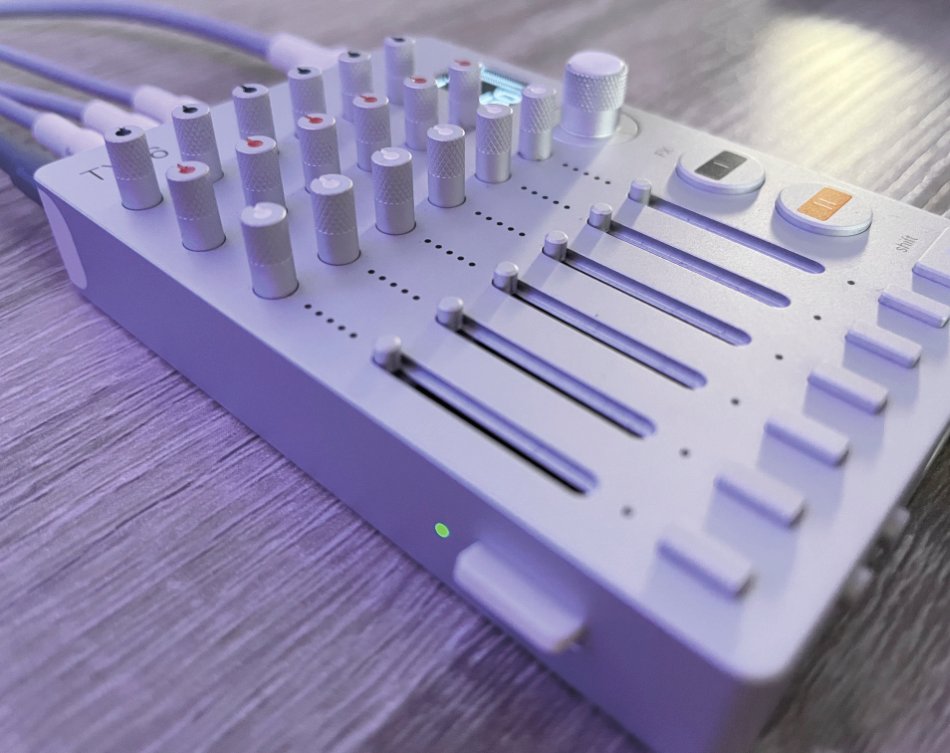
The TX-6 is a 12-channel audio interface. Yeah. It lets you multitrack 12 instruments into your DAW of choice (on Mac and iOS) – and due to its MFi certification – it even lets you do this on an iPhone – without any adapters. This is insane – and it’s one of the greatest features of the TX-6. A ridiculously tiny audio interface? Extremely practical.
Of course, it goes without saying that it sounds great. The inputs all use TI’s TLV320ADC3140 burr-brown ADCs, while the main and aux outputs use Cirrus’ high-end MasterHIFI CS43131 DAC, while the cue out uses a lower-end CS47L35 for lower power consumption and longer battery life. This makes it one of the cleanest sounding audio interfaces out there – blowing the Focusrite Scarlett series out of the water – and sounding on par with high-end interfaces like the UA Apollo Twin.
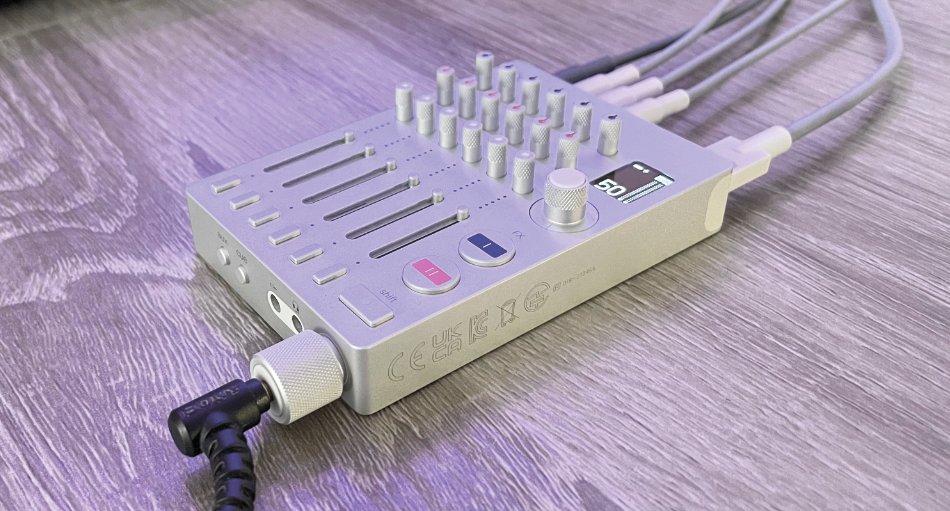
All three of these outputs can be routed in various ways and used for sending sound to external recorders, creating effect loops or monitoring. There’s even the option of switching the DACs the cue and aux outputs use, if critical monitoring is required, or if higher-impedance headphones are used (when 2 Vrms are needed, instead of the 1 Vrms the CS47L35 can deliver). Routing in general is what the two buttons on the bottom edge of the TX-6 are for. You can mute single tracks on specific outs or even change track levels between outputs. It’s also possible to reconfigure the TX-6 to act as a 2-in/2-out interface if stereo mixdowns are what you’re after, and not multitracking.
And then, there’s still more to this fascinating little device. It’s got an on-board audio recorder (that was the first major update) – and is able to record right onto a USB drive without any computer required. This is crazy powerful, as it essentially enables you to use the TX-6 as the main recording unit in a DAW-less setup. The audio files sound just as good as the ones recorded with a DAW – and are recorded in stereo.
There’s also a synth on-board (of course there is). It’s limited to a few simple drum sounds and basic sine/triangle/square waveforms – with only the filter as a real modulation option. A basic pattern sequencer is available – and each of the six independent track voices can be controlled via a MIDI channel. This makes it quite powerful – especially given the clear sound. It is definitely a whimsical and kooky feature on a mixer – but can be useful in a pinch when an extra melodic line or a drum machine voice is needed.
TX-6 also has Bluetooth – which can be used to send clock to or from the TX-6, and can be used for MIDI as well. MIDI over USB is, of course, also present. The battery lasts about eight hours on a single charge – which is more than decent. Once you truly realise how much stuff the TX-6 packs in – it’s kind of impressive, even.
There are a few drawbacks, however – including the 1199€ price (it’s steep, we know – but it’s justified). There’s also no mic preamps (but how would you fit those in a box so small)? The channel inputs are spaced so tightly together that super slimline cables are required (but not custom ones, thankfully). Yeah – the whole unit might be a tad small and the controls might feel a tad too cramped at times, but it didn’t bother us and never got in the way of usability – though for those with the largest of hands it might be somewhat problematic. There’s not much more negative which can be said about the TX-6 without seriously nitpicking.
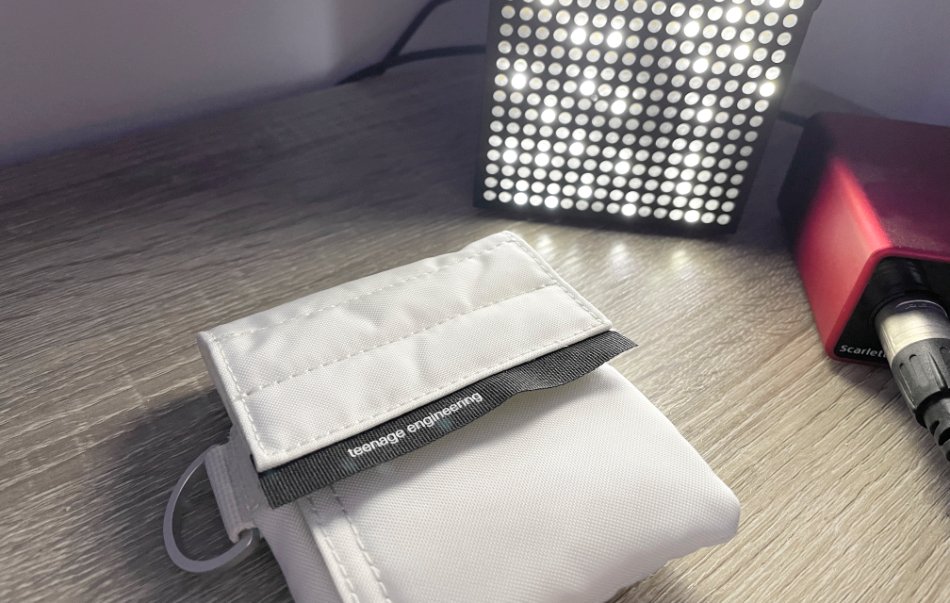
Consider how much the TX-6 brings to the table – it’s a fully fledged 12-channel portable mixer and interface – existing in a product niche of its own – capable of working standalone. It’s an effects box with both classic and uniquely creative effects. It’s a portable audio recorder. It’s a tiny drum machine and synth. It’s so much in one tiny device – and it feels gorgeous to use.
We truly think it’s a little box of wonders – continuing the tradition of the company’s previous designs. It turns your backpack into a portable recording studio – and takes up next to no space (in fact, it’s smaller than your average pocket operator).
Let’s quickly cover the custom cables and the carrying case which we also got. They are gorgeous! The cables are made of silicone, with long strain reliefs and cute branding on the jacks. They are – of course – slimline cables, able to easily fit into the ports of the TX-6. At 10€ a piece, they aren’t cheap – but they are definitely worth it.
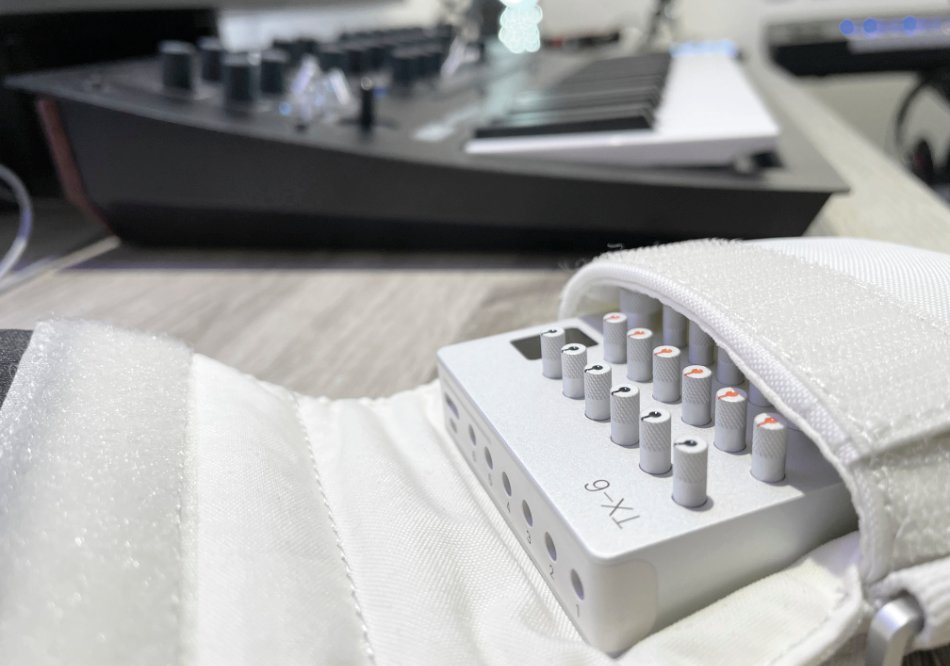
The case is made out of fabric with a velcro strap for closing, a belt hook, and several more velcro attachment straps on the back. There’s a tiny pocket for storing adapters or small cables at the front – and that’s it. It’s a minimal bag – but it keeps your TX-6 safe and it looks really stylish. We love it! The bag retails for 59€ and is a bit pricey – but is the best (and official) way to keep your TX-6 scratch-free.
In conclusion, while spending over a thousand euros on a tiny piece of kit might seem odd – and its looks might not fully convey how truly professional it is – the TX-6 is a serious tool. It does so many jobs perfectly, and can be used as a fully-fledged 12-track interface, standalone mixer, recorder, back-up synth or effects pedal. Its small size might prove a bit unwieldy for large hands – but for most it will be one of the key selling points. Overall, it’s easy for us to recommend the TX-6 to those looking to boost their mobile production setups. For some it might even be the perfect studio interface for synth work – since it’s more than a capable and worthy interface, even with its portability ignored.
Finally, here’s an example of an entire project which uses the TX-6 as the main mixer and audio interface. Put your heaphones on! The clean but powerful bass response is especially noteworthy, as is the general dynamic range. Additional processing was done in Logic Pro.
More information: https://teenage.engineering
- teenage engineering OP-XY review: after dark - 06/01/2025
- Mehatronika interviews: Rodrigo Sim - 05/17/2025
- LattePanda Mu i3-N305 review: More power - 03/16/2025
